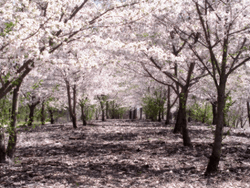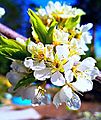Cherry blossom facts for kids
Quick facts for kids Japanese Cherry |
|
|---|---|
 |
|
| Somei Yoshino Sakura | |
| Scientific classification | |
| Kingdom: | |
| Division: | |
| Class: |
Magnopsida
|
| Order: | |
| Family: | |
| Subfamily: | |
| Genus: | |
| Species | |
|
Prunus jamasakura |
|
Cherry blossoms, also known as sakura (pronounced sah-koo-rah), are the beautiful flowers of cherry trees. In Japan, these trees are a big symbol of spring! While they are super popular, they are not actually Japan's national flower. The word 'Sakura' is also a popular name for girls.
People in Japan have a special tradition called Hanami, which means 'flower viewing'. They visit parks and gardens to enjoy the sakura when they are blooming. The Somei Yoshino is the most famous type of cherry blossom.
Contents
What are Cherry Blossoms?
Cherry blossoms come from cherry trees. The fruit we eat, cherries, usually comes from a different kind of cherry tree. These lovely flowers are a sign that spring has arrived.
Types of Cherry Trees
There are about 400 different kinds of cherry trees! They can change and create new types quite easily.
The Flowers
Most cherry blossoms are white or pink. They usually have five petals. But some special types can have almost a hundred petals on one flower!
Fun Cherry Blossom Words
- Hanahubuki (hah-nah-hoo-boo-kee) is a cool word. It means when cherry petals fall from the trees like snow.
- Cosmos flowers are sometimes called Akizakura (ah-kee-zah-koo-rah). This means 'autumn cherry blossoms' because their shape looks a bit like sakura.
Eating Cherry Blossoms
Did you know that cherry blossoms and their leaves can be eaten? In Japan, they are used in many foods:
- The blossoms are often pickled in salt and a special vinegar called umezu. These pickled blossoms are used to add flavor to Japanese sweets called wagashi. They are also used in sweet buns called anpan.
- You can also make a special drink called sakurayu. This is made by putting salt-pickled blossoms in hot water. People often drink sakurayu at happy events like weddings instead of green tea.
- The leaves of the Oshima cherry tree are also pickled in salt water. These soft leaves are used to wrap a sweet rice cake called sakuramochi.
It's important to know that cherry leaves have something called coumarin. Eating too much coumarin can be harmful. So, it's best not to eat a lot of the leaves.
Related Pages
Images for kids
-
Prunus speciosa (Oshima cherry). This type of cherry tree helped create many different kinds of cherry blossoms.
-
Prunus serrulata 'Kanzan' or 'Sekiyama'. This is a very popular cherry tree in Europe and North America.
-
Yachounomori Garden, Tatebayashi, Gunma, Japan.
-
Yoshino cherry. These trees bloom at the same time when grown in the same place.
-
Prunus × yedoensis 'Somei-yoshino' (Yoshino cherry). This is the most popular cherry tree in Japan and Asia.
-
A woodblock print of Mount Fuji and cherry blossoms by Hiroshige.
-
'Kanzan' is a 'double-flowered' type. It has 20 to 50 petals on one flower.
-
Cherry blossoms at Himeji Castle, Japan.
-
Prunus itosakura 'Pendula Rosea' (Beni-shidare). This tree, called "Miharu Takizakura", is over 1000 years old.
-
A panoramic view of the Japanese gardens in Cowra, Australia.
-
Cherry blossoms in Canada, Niagara-on-the-Lake, Ontario.
-
Blooming cherry blossom trees in Parc de Sceaux, France.
-
Cherry blossoms on Breite Strasse in Bonn, North Rhine-Westphalia, Germany.
-
Prunus cerasoides is a wild Himalayan cherry tree, common in India.
-
Cherry blossoms at POSTECH, South Korea.
-
Cherry blossoms in Turkey.
-
Cherry blossoms in Washington, D.C..
-
Cherry blossoms in Newark, New Jersey.
-
Cherry blossoms in Owensboro, Kentucky.
-
BC Legislative Building with cherry trees in bloom, Victoria, British Columbia.
-
Cherry blossoms in Canada, Niagara-on-the-Lake, Ontario.
-
Spring cherry blossoms at the university campus, Vancouver, Canada.
-
Cherry blossoms at Hamilton, Canada.
-
Cherry blossom at Osaka Castle.
-
Thousands of people attend the annual National Cherry Blossom Festival every spring in Washington, D.C.
See also
 In Spanish: Sakura (cerezo) para niños
In Spanish: Sakura (cerezo) para niños















































